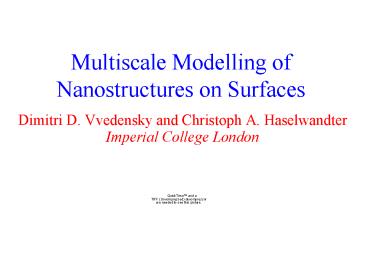Multiscale Modelling of Nanostructures on Surfaces - PowerPoint PPT Presentation
1 / 24
Title: Multiscale Modelling of Nanostructures on Surfaces
1
Multiscale Modelling ofNanostructures on Surfaces
- Dimitri D. Vvedensky and Christoph A.
Haselwandter - Imperial College London
2
Outline
- Multiscale Modelling Quantum Dots
- Lattice Models of Epitaxial Growth
- Exact Langevin Equations on a Lattice
- Continuum Equations of Motion
- Renormalization Group Analysis
- Heteroepitaxial Systems
3
Synthesis of Semiconductor Nanostructures
4
Structure of Quantum Dots
Georgsson et al. Appl. Phys. Lett. 67,
29812983 (1995)
K. Jacobi, Prog. Surf. Sci. 71,
185215 (2003)
5
Stacks of Quantum Dots
Goldman, J. Phys. D 37, R163R178 (2004)
6
Theories of Quantum Dot Formation
- Quantum mechanics
- Accurate, but computationally expensive
- Molecular dynamics
- Requires accurate potentials, long simulation
times - Statistical mechanics and kinetic theory
- Fast, easy to implement, but need parameters
- Partial differential equations
- Large length and long time scales relation to
atomic processes?
7
Size Matters
8
Review Vvedensky, J. Phys Condens. Matter 16,
R1537 (2004)
9
Basic Atoms-to-Continuum Method
10
EdwardsWilkinson Model
Edwards and Wilkinson, Proc. Roy. Soc. London
Ser. A 381, 17 (1982)
11
The Wolf-Villain Model
Clarke and Vvedensky, Phys. Rev. B 37, 6559 (1988)
Wolf and Villain, Europhys. Lett. 13, 389 (1990)
12
Coarse-Graining Road Map
renormalization group
Macroscopic equation
Continuum equations
(crossover, scaling, self-organization)
Haselwandter and DDV (2005)
KMC simulations
Lattice Langevin equation
exact
Chua et al. Phys Rev. E (2005)
equivalent analytic
Master Chapman Kolmogorov equations
Lattice rules for growth model
formulation
13
Coarse-Graining Road Map
14
Renormalization Group Equations
15
WolfVillain Model in 1D
16
WolfVillain Model in 2D
(f)
(i)
17
Analysis of Linear Equation
18
Low-Temperature Growth of Ge(001)
Bratland et al., Phys. Rev. B 67, 125322 (2003)
- T 95170 ºC
- F 0.1 ML/s
- DGe 0.6 eV
- tGe hours!
19
Model for Quantum Dot Formation
Rb gt Ra Rc gt Ra Rd lt Ra
Ratsch, et al., J. Phys. I (France) 6, 575 (1996)
20
KMC Simulations of Quantum Dots
- KMC simulations with
- Random deposition
- Nearest-neighbor hopping
- Detachment barriers calculated
- from Frenkel-Kontorova
- model
Ratsch, et al., J. Phys. I (France) 6, 575 (1996)
21
Basic Lattice Model for Quantum Dots
- Random deposition
- Nearest-neighbor hopping
- Total barrier to hopping ED ES nEN
- ES from substrate, EN from each nearest
neighbor, n 0, 1, 2, 3, or 4 - Detachment barrier a function of height only EN
EN(h)
22
PDE for Quantum Dots
23
Numerical Morphology
24
Summary, Conclusions, Future Work
- Systematic lattice-to-continuum concurrent
multiscale method - Ge(001) mechanism responsible for smooth growth
early during growth leads to instability at later
times - Application to simple model of quantum dot
formation - Applications to other models (Poster Christoph
Haselwandter) - Submonolayer growth
- Systematic treatment of heteroepitaxy
- More realistic lattice models?































